Archive for the 'Vegetables' Category
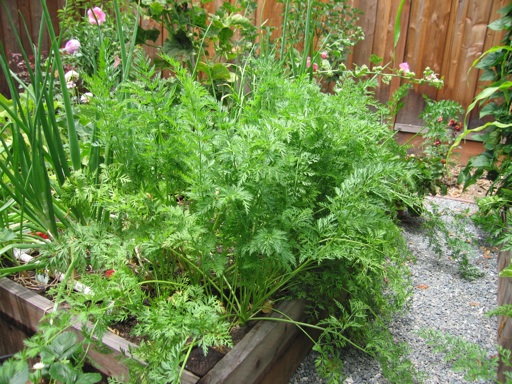

Carrots have been one of the most enjoyable vegetables to grow in our garden. Back in early April, I planted seeds for red, yellow, white, and purple carrots. Most of the seeds sprouted as extremely tiny seedlings, but they grew very fast. After 3 months, they have grown so large that they are crowding each other (see top picture).
Some of our carrots went to seed before they developed more than a tiny little carrot. But most of them have not seeded yet. Carrots are supposed to be a spring or fall crop, because they tend to go to seed too soon in hot summer weather. Perhaps our relatively mild summers (highs averaging around 80 F) have kept most of them from seeding prematurely.
Many of our carrots are ready to harvest. On the seed package, it says 65-75 days to maturity, but our carrots seem to be taking longer than that. Also, carrots appear to last in the ground for a long time without going bad or losing flavor.
I determine when carrots are ready to harvest by digging around the top of the root to see when the carrot appears to have grown to a full size. (see bottom picture) Harvesting carrots is very fun, because it’s always a surprise when you pull them up and find out how big they are.
July 18 2009 | Carrots | Comments Off on Carrot Patch
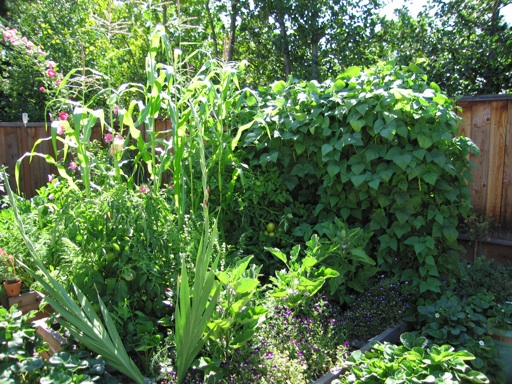
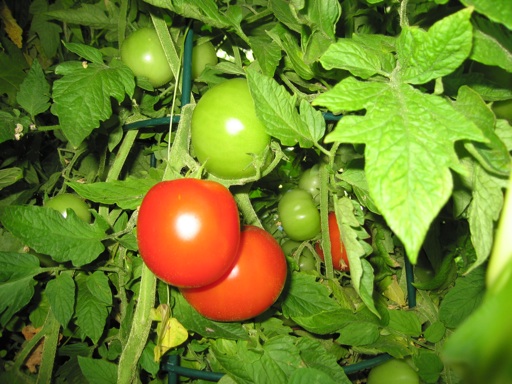
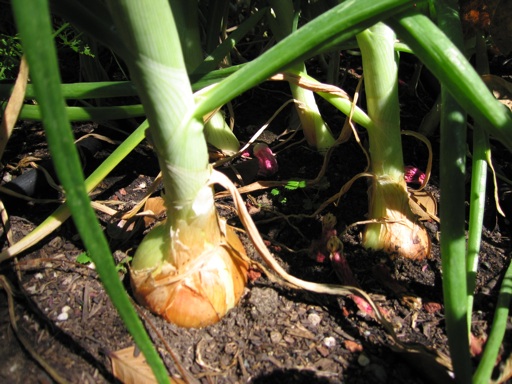
We have been growing vegetables in two 6′ x 7′ raised beds since last summer. In these two small beds, we are growing several different types of fruits and vegetables including peppers, eggplant, zucchini, green beans, tomatoes, corn, carrots, onions, cantaloupe, and honey dew.
Our most successful plants so far are the green beans and zucchinis. They are producing more green beans and zucchinis than we can eat. Only a few of the tomatoes on our two tomato plants are have ripened so far (see second picture), but there are dozens of green tomatoes hanging on the vines.
Several of our carrots and onions are just about ready to harvest. The third picture shows some of the walla walla onions we are growing this season. Our corn stalks have reached their maximum height and are now starting to grow small corn ears.
Our eggplants and peppers are growing several small fruits. Although the peppers have not grown very much since I planted them in April. They seem to be getting crowded by the beans, carrots, and tomatoes growing next to them. One of the problems with growing so many different types of plants in a small area is that the slow growing plants like peppers and eggplant tends to get crowded by the faster growing plants. Next year, I may try to plant the slower growing plants together in one bed and the faster growing plants in the other bed.
I haven’t fertilized most of the plants in our vegetable garden since mid-May. I was fertilizing them with water soluble fertilizer for about the first 6 six weeks after planting. After that, most of the vegetables started growing so fast that I decided to stop the fertilizing. I have only been continuing to fertilize the eggplants and peppers in an attempt to get them to grow more.
I have also been fertilizing our strawberries about once a week. I know that sounds like a lot of fertilizer, but they have been producing strawberries continuously since early May. They show no signs of slowing down their fruit production yet. I have been harvesting a small bowl full of berries every few days for over two months. I attribute the huge production of berries to all the fertilizer. Last year, they stopped producing berries in early June. But as soon as I started fertilizing them, they begin to produce berries again.
Our strawberries are growing in pots around the raised beds, which makes it easy to pick them. Strawberries tend to rot quickly when the fruits are lying directly on damp soil. The berries mostly hang over the edges of the pots, so the berries stay dry.
July 12 2009 | Onions and Strawberries and Tomatoes and Vegetables | Comments Off on Vegetable Garden Update


For a long time, I have wanted to grow a vegetable garden like the one my family had when I was growing up. For six years after I moved into my current house, I assumed that I did not have enough time to plant and tend to a vegetable garden. Last year, I realized that I may not have any more free time to tend to a vegetable garden until I retire. I didn’t want to wait that long (at least 25 years away), so I decided to try and make the time.
I wanted raised beds instead of a ground level garden to make it easier to amend the soil and keep the snails away. Rather than spend the time building it myself, I decided to pay the money to have a gardener dig up our side yard lawn, build two raised beds, and put in an automatic watering system.
Once those tasks were completed, it turns out that the vegetable garden did not require a substantial amount of my time. It takes a few hours to visit a nursery, buy the seeds and the transplants, and then plant them. After that, the automatic watering system takes care of the watering. I just need to fertilize and do a bit of weeding once every few weeks. Fertilizing and weeding doesn’t take me much time, because our raised beds are small, one is 6′ x 7′ and the other is 6′ x 8′. Harvesting the produce is the only additional task that needs to be done, and harvesting produce from my yard takes much less time than a trip to the grocery store.
I was telling all of this to one of my neighbors just yesterday. I think I may have convinced her to put in a vegetable garden in her yard.
Over the past several weeks, I have been planting this year’s vegetable garden in our two raised beds. I started this year’s plantings with broccoli in late February. In March, I planted pole bean seeds, cantaloupe and honey dew seeds, carrot seeds, tomato transplants, a zucchini transplant, a basil transplant, onion transplants, and cilantro transplants. So far in April, I have added bell peppers, an eggplant, summer squash transplants, and day neutral strawberry transplants. I also planted violas and hollyhocks to add a bit more visual appeal to the garden. In addition, I planted spinach seeds and garlic transplants last fall that are still growing.
I collected the pole bean seeds from dried up bean pods on last year’s bean plants. All of these bean seeds sprouted quickly, and they are already several inches high, as can be seen in the back of the first picture. I built a simple support for them that is made of two thin wooden posts, and a sturdy metal wire frame that is hanging on hooks I screwed into the wooden posts.
Most of the cantaloupe and honey dew seeds sprouted, but birds ate most of them soon after. Even though I covered them in netting, the birds picked at them through the netting. I know it was birds, because I found feathers near the picked-at seedlings. Frustrated with that experience, I replaced them with cantaloupe transplants I bought from a local nursery. The birds have not touched these yet, probably because they are already large enough to be unappealing.
I planted two sets of the carrot seeds, once in early March and a second one in early April. Many of the carrot seeds I planted in early March didn’t spout. The carrot seeds I planted a few weeks ago are just starting to emerge. This year, I planted white and purple carrots in addition to the yellow and red carrots I planted last year. The yellow carrots did especially well last year. It’s so fun to see such tiny seeds turn into large colorful carrots in just a few months!
April 18 2009 | Vegetables | Comments Off on Vegetable Garden Planted
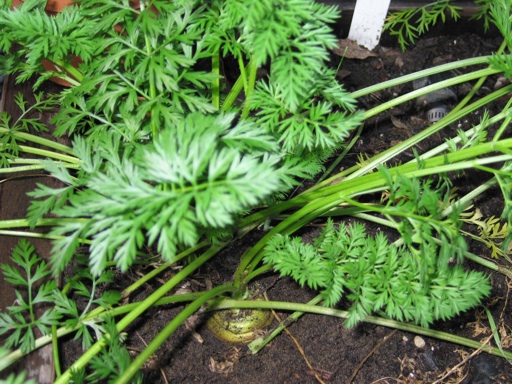
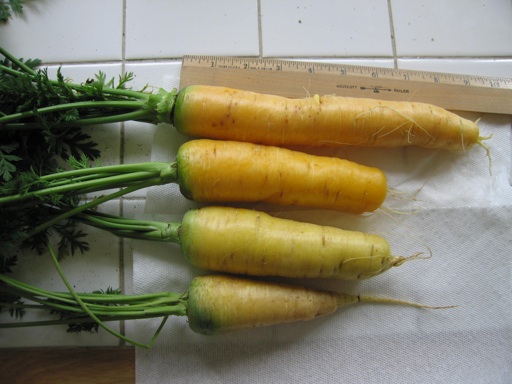
Nearly all of the plants in our vegetable garden are dead or dying. The one exception is the carrots I planted by seed last summer. We planted yellow and red carrot seeds, because we thought they would be interesting novelty plants. The carrots look healthy right now despite the cold weather we have been having.
Several nights last week, the temperatures here fell into the low 30s F. The frost damaged the leaves of our brugmansia and plumeria plants. However, the carrots appear to have been unaffected by the cold temperatures. The leaves still look green and healthy. The high temperatures here have been in the upper 40s to low 50s for weeks.
Today, I harvested our first carrots, shown in the above pictures. Obviously, one doesn’t know what an individual carrot will look like until it’s uprooted. So I was very excited to pull them out of the ground and discover nicely developed carrots attached to the leaves. The surprise factor adds an interesting dimension to growing carrots. These appear to be yellow carrots. The largest one is about 9 inches in length. The thickest one is about 1.75 inches in width. I can’t wait to taste them. We are going to serve them for Christmas eve dinner. I haven’t grown carrots since I was a child, and I remember not having much luck with them back then.
I have read that one of the keys to growing carrots is to grow them in at least a foot of loosely packed soil that is free of rocks. Otherwise, the carrots may not develop to their full length or may develop forks. Growing them in a foot-high raised bed filled with compost seems to have helped.
December 23 2008 | Carrots | Comments Off on Yellow Carrots
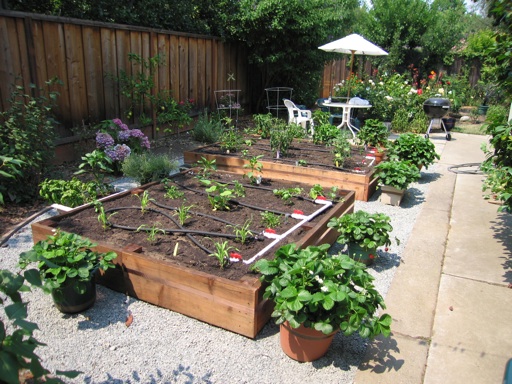
Last week, I converted a lawn in my side yard into a vegetable garden. The garden includes two raised beds made of 12” x 2” untreated redwood. One bed is 6’ x 7’, and the second bed is 8’ x 6’. I decided not to make the beds wider than 6’ so that it would be easy to reach the plants without walking in the garden. The wood is secured into the ground with 4” stakes in each corner that are embedded in cement like fence posts.
Each garden bed is surrounded by 2’- 2.5’ wide gravel paths that have weed block underneath to make the plants more easily accessible.
Each bed has four soaker hoses that are set on a timer to water daily. Each of the eight soaker hoses has a red shut off valve. Each shut off valve can be turned on or off to supply water to the soaker hose. In the wintertime, I may decide to grow plants in only a portion of the garden. So I added the shut off valves to have the flexibility to water only the portion of the garden that has plants.
I haven’t had a vegetable garden since I was a child. Back then, my parents filled in an old sandbox with dirt, and we started growing vegetables. My sister and I had a lot of fun each summer taking care of the plants and watching them grow. We had fun watching the plants grow quickly and produce fruit within only a few months in the warm spring and summer weather.
Last week, my mom and I planted a variety of warm weather vegetables, fruits, and herbs. We planted a six pack of corn, 3 tomatoes, 5 peppers, 3 eggplant, 6 basil, 3 groups of cilantro, a six pack of onions, one set of zucchinis, and one set of cantaloupes. Because I am getting the garden started relatively late, I bought mostly larger seedlings to give them a head start. After planting, I gave them a thorough watering and shot of water soluble fertilizer.
The next day I put adhesive copper tape around the wooden perimeter of each of the raised beds. The copper tape helps to keep the snails and slugs out of the garden. They don’t seem to cross the copper tape. I have had a lot of luck using copper tape to keep snails out of my strawberry pots. It’s a great organic way to deal with snails without having to use pesticide near edible produce.
July 13 2008 | Fruit and Vegetables | Comments Off on New Vegetable Garden
« Prev









